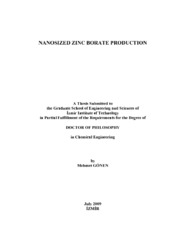Please use this identifier to cite or link to this item:
https://hdl.handle.net/11147/3002Full metadata record
| DC Field | Value | Language |
|---|---|---|
| dc.contributor.advisor | Balköse, Devrim | - |
| dc.contributor.author | Gönen, Mehmet | - |
| dc.date.accessioned | 2014-07-22T13:48:44Z | - |
| dc.date.available | 2014-07-22T13:48:44Z | - |
| dc.date.issued | 2009 | - |
| dc.identifier.uri | http://hdl.handle.net/11147/3002 | - |
| dc.description | Thesis (Master)--Izmir Institute of Technology, Chemical Engineering, Izmir, 2009 | en_US |
| dc.description | Includes bibliographical references (leaves: 183-189) | en_US |
| dc.description | Text in English; Abstract: Turkish and English | en_US |
| dc.description | xxiii, 195 leaves | en_US |
| dc.description.abstract | The present study covers both zinc borate synthesis from boric acid-zinc oxide and borax decahydrate-zinc nitrate hexahydrate pairs; treatment of those samples by supercritical carbon dioxide drying, supercritical ethanol drying, and freeze drying techniques to obtain nanosized products. Zinc borate samples before and after supercritical drying were characterized by analytical titration, SEM, XRD, TGA, DSC, FTIR, and N2 adsorption at 77 K.The use of oleic acid as a modifying agent, ultrasonic treatment and nanosized zinc oxide in the reaction of zinc oxide and boric acid did not make significant effect in controlling the particle size. However, particle size of zinc borate produced from borax and zinc nitrate has increased with reaction time. Interaction of zinc borates with CO2 or ethanol at supercritical conditions or compression of crystals by high pressure created by the expansion of water during freezing are possible side effects of the nanoparticle producing processes. Zinc borate (2ZnO.3B2O3.7H2O) having water of crystallization in its structure reacted partially with CO2 to produce zinc carbonate, however zinc borate (2ZnO.3B2O3.3H2O) containing only hydroxyl groups did not react with CO2 in supercritical CO2 drying. While zinc borate (2ZnO.3B2O3.3H2O) decomposed partially and formed anhydrous zinc borate and zinc oxide, zinc borate (ZnO.B2O3.2H2O) decomposed completely and formed only zinc oxide in the supercritical ethanol drying that was carried out at 6.5 MPa and 250aC. Boric acid formed from the decomposition of both zinc borates was separated by ethanol extraction. If the initial particle size of zinc borate sample was at nano level, it would be possible to obtain nano particles by freeze drying. | en_US |
| dc.language.iso | en | en_US |
| dc.publisher | Izmir Institute of Technology | en_US |
| dc.rights | info:eu-repo/semantics/openAccess | en_US |
| dc.subject.lcc | TP245.Z7 .G66 2009 | en |
| dc.subject.lcsh | Zinc compounds | en |
| dc.subject.lcsh | Boron compounds | en |
| dc.subject.lcsh | Supercritical fluids | en |
| dc.subject.lcsh | Nanotechnology | en |
| dc.title | Nanosized zing borate production | en_US |
| dc.type | Doctoral Thesis | en_US |
| dc.department | Thesis (Doctoral)--İzmir Institute of Technology, Chemical Engineering | en_US |
| dc.relation.publicationcategory | Tez | en_US |
| item.openairecristype | http://purl.org/coar/resource_type/c_18cf | - |
| item.languageiso639-1 | en | - |
| item.openairetype | Doctoral Thesis | - |
| item.grantfulltext | open | - |
| item.fulltext | With Fulltext | - |
| item.cerifentitytype | Publications | - |
| Appears in Collections: | Phd Degree / Doktora | |
Files in This Item:
| File | Description | Size | Format | |
|---|---|---|---|---|
| T000817.pdf | DoctoralThesis | 13.07 MB | Adobe PDF |  View/Open |
CORE Recommender
Page view(s)
340
checked on Mar 31, 2025
Download(s)
344
checked on Mar 31, 2025
Google ScholarTM
Check
Items in GCRIS Repository are protected by copyright, with all rights reserved, unless otherwise indicated.